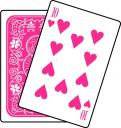 A pack of cards is a great resource for helping with maths at home. Here is a simple game that can help to develop the concepts of more and less.
A pack of cards is a great resource for helping with maths at home. Here is a simple game that can help to develop the concepts of more and less.
What you need:
- A pack of cards
- Paper to keep a tally score (optional)
What to do:
Take a pack of cards and remove all the Kings, Queens and Jacks.
Give the rest of the pack a good shuffle and deal 10 cards between you and your child. Make sure they stay face down in a pile in front of each of you.
Decide whether the winner will be the person with ‘more’ ( a higher card) or ‘less’ (a lower card). This could be done by tossing a coin.
Each player turns over one card and they are compared. Is it more or is it less? The winner keeps both cards, or a score can be marked on paper.
After all the cards have been turned over the winner is the one with most cards or the highest score.
Further info:
This is an excellent way to develop a sense of number. Children can count the shapes on the cards and match them to the numbers shown on the cards, as well as learning what more and less mean.
Talk with your child about the cards which have been turned over ( “Wow! You’ve got a really high card!” “ Is mine more than yours?” etc)
Vary the number of cards dealt; 5 may be enough to start with.
If you want to make the scoring much trickier the winner could score the difference between the two cards (i.e. if a 7 and a 4 are turned over the winner scores 7 – 4 = 3.)